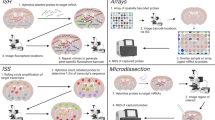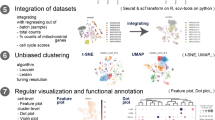Abstract
To study the rDNA contacts with genes in three human cell lines of different origin, we used 4C approach. Our data indicate that the same set of about five hundred genes frequently shape contacts with rDNA clusters in HEK293T, K652, and hESM01 cells. Gene ontology search suggests that the genes are involved in development and morphogenesis. Approximately one hundred of these genes are highly associated with silencing by H3K27me3 mark in different normal cells, including bronchial epithelial cells, keratinocytes, myoblasts, monocytes, endothelial cells, kidney epithelial cells, and some others. We conclude that the concerted silencing of specific group of rDNA-contacting genes controlling development occurs during differentiation. We assume that the phase separation mechanisms may be involved in the rDNA-mediated silencing of a set of genes via the contacts with inactive rDNA clusters.

Similar content being viewed by others
REFERENCES
Dekker, J., Rippe, K., and Dekker, M., Capturing chromosome conformation, Science, 2002, vol. 95, pp. 1306–1311. https://doi.org/10.1126/science.1067799
Sidorenko, D.S., Sidorenko, I.A., Zykova, T.Y., Goncharov, F.P., Larsson, J., and Zhimulev, I.F., Molecular and genetic organization of bands and interbands in the dot chromosome of Drosophila melanogaster, Chromosoma, 2019, vol. 128, pp. 97–117. https://doi.org/10.1007/s00412-019-00703-x
Ghavi-Helm, Y., Jankowski, A., Meiers, S., Viales, R.R., Korbel, J.O., and Furlong, E.E.M., Highly rearranged chromosomes reveal uncoupling between genome topology and gene expression, Nat. Genet., 2019, vol. 51, no. 8, pp. 1272–1282. https://doi.org/10.1038/s41588-019-0462-3
Sarnataro, S., Chiariello, A.M., Esposito, A., Prisco, A., and Nicodemi, M., Structure of the human chromosome interaction network, PLoS One, 2017, vol. 12, no. 11. e0188201. https://doi.org/10.1371/journal.pone.0188201
Ananiev, E.V., Barsky, V.E., Ilyin, Y.V., and Churiko, N.A., Localization of nucleoli in Drosophila melanogaster polytene chromosomes, Chromosoma, 1981, vol. 81, pp. 619–628. PMID: 6790245
Tchurikov, N.A., Fedoseeva, D.M., Sosin, D.V., Snezhkina, A.V., Melnikova, N.V., Kudryavtseva, A.V., Kravatsky, Y.V., and Kretova, O.V., Hot spots of DNA double-strand breaks and genomic contacts of human rDNA units are involved in epigenetic regulation, J. Mol. Cell. Biol., 2015, vol. 7, pp. 366–382. https://doi.org/10.1093/jmcb/mju038
Hnisz, D., Abraham, B.J., Lee, T.I., Lau, A., Saint-André, V., Sigova, A.A., Hoke, H.A., and Young, R.A., Super-enhancers in the control of cell identity and disease, Cell, 2013, vol. 155, pp. 934–947. https://doi.org/10.1016/j.cell.2013.09.053
Savić, N., Bär, D., Leone, S., Fromme, S.C., Weber, F.A., Vollenweider, E., Ferrari, E., Ziegler, U., Kaech, A., Shakhova, O., Cinelli, P., and Santoro, R., lncRNA maturation to initiate heterochromatin formation in the nucleolus is required for exit from pluripotency in ESCs, Cell Stem Cell, 2014, vol. 15, pp. 720–734. https://doi.org/10.1016/j.stem.2014.10.005
Tchurikov, N.A., Fedoseeva, D.M., Klushevskaya, E.S., Slovohotov, I.Y., Chechetkin, V.R., Kravatsky, Y.V., and Kretova, O.V., rDNA clusters make contact with genes that are involved in differentiation and cancer and change contacts after heat shock treatment, Cells, 2019, vol. 8, no. 11, p. 1393. https://doi.org/10.3390/cells8111393
Lagarkova, M.A., Shutova, M.V., Bogomazova, A.N., Vassina, E.M., Glazov, E.A., Zhang, P., Rizvanov, A.A., Chestkov, I.V., and Kiselev, S.L., Induction of pluripotency in human endothelial cells resets epigenetic profile on genome scale, Cell Cycle, 2010, vol. 9, pp. 937–946.
Kretova, O.V., Fedoseeva, D.M., Kravatsky, Y.V., Alembekov, I.R., Slovohotov, I.Y., and Tchurikov, N.A., Homeotic DUX4 genes that control human embryonic development at the two-cell stage are surrounded by regions contacting with rDNA gene clusters, Mol. Biol. (Moscow), 2019, vol. 53, no. 2, pp. 268–273. https://doi.org/10.1134/S0026898419020083
Tchurikov, N.A., Klushevskaya, E.S., Kravatsky, Y.V., Kravatskaya, G.I., Fedoseeva, D.M., and Kretova, O.V., Interchromosomal contacts of rDNA clusters with DUX genes in human chromosome 4 are very sensitive to heat shock treatment, Dokl. Biochem. Biophys., 2020, vol. 490, no. 1, pp. 50–53. https://doi.org/10.1134/S1607672920010032
Lavarone, E., Barbieri, C.M., and Pasini, D., Dissecting the role of H3K27 acetylation and methylation in PRC2 mediated control of cellular identity, Nat. Commun., 2019, vol. 10, p. 1679. https://doi.org/10.1038/s41467-019-09624-w
Kretova, O.V., Fedoseeva, D.M., Kravatsky, Y.V., Klushevskaya, E.S., Alembekov, I.R., Slovohotov, I.Y., and Tchurikov, N.A., Contact sites of rDNA clusters with FANK1 gene correspond to repressed chromatin, Mol. Biol. (Moscow), 2020, vol. 54, no. 2, pp. 262–266. https://doi.org/10.31857/S002689842002007X
Shrinivas, K., Sabari, B.R., Coffey, E.L., Klein, I.A., Boija, A., Zamudio, A.V., Schuijers, J., Hannett, N.M., Sharp, P.A., Young, R.A., and Chakraborty, A.K., Enhancer features that drive formation of transcriptional condensates, Mol. Cell, 2019, vol. 75, pp. 549–561. https://doi.org/10.1016/j.molcel.2019.07.009
You, K., Huang, Q., Yu, C., Shen, B., Sevilla, C., Shi, M., Hermjakob, H., Chen, Y., and Li, T., PhaSepDB: a database of liquid-liquid phase separation related proteins, Nucleic Acids Res., 2020, vol. 48, no. D1, pp. D354–D359. https://doi.org/10.1093/nar/gkz847
ACKNOWLEDGMENTS
The authors are grateful to M.A. Lagarkova for providing hESM01 cells.
Funding
This study was supported by the Russian Science Foundation (project no. 18-14-00122) and the Russian Foundation for Basic Research (project nos. 20-04-01134 and 18-04-00198).
Author information
Authors and Affiliations
Corresponding author
Ethics declarations
The authors declare that they have no conflict of interest. This article does not contain any studies involving animals or human participants performed by any of the authors.
Additional information
Translated by M. Batrukova
Rights and permissions
About this article
Cite this article
Tchurikov, N.A., Klushevskaya, E.S., Kravatsky, Y.V. et al. Interchromosomal Contacts of rDNA Clusters in Three Human Cell Lines Are Associated with Silencing of Genes Controlling Morphogenesis. Dokl Biochem Biophys 496, 22–26 (2021). https://doi.org/10.1134/S1607672921010038
Received:
Revised:
Accepted:
Published:
Issue Date:
DOI: https://doi.org/10.1134/S1607672921010038




